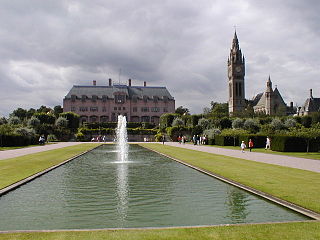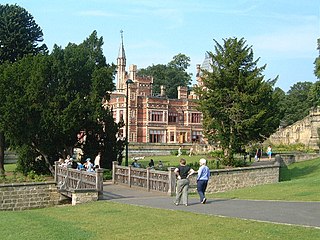
Yarm-on-Tees, or simply Yarm, is a market town in North Yorkshire, England. It lies on a meander of the River Tees, extending south-east to the River Leven and south to the village of Kirklevington. A civil parish in the Borough of Stockton-on-Tees, Yarm is near the towns of Stockton-on-Tees, 5 miles (8.0 km) to its northeast, and Darlington, 11 miles (18 km) to its west.

Sefton Park is a public park in south Liverpool, England. The park is in a district of the same name, located roughly within the historic bounds of the large area of Toxteth Park. Neighbouring districts include modern-day Toxteth, Aigburth, Mossley Hill, Wavertree and St Michael's Hamlet.

The Birmingham Botanical Gardens are a 15-acre (6-hectare) botanical garden situated in Edgbaston, Birmingham, England. The gardens are located 1+1⁄2 miles (2.4 km) south-west of Birmingham city centre at grid reference SP049854. Designed in 1829, the gardens are Grade II* listed in Historic Englands's Register of Parks and Gardens, and retain many original features and layout, which was designed by the landscape gardener and horticulturalist John Claudius Loudon. The site is notable for its range of glasshouses and gardens, which display a wide variety of plants and previously, birds. Birmingham Botanical Gardens is managed by Birmingham Botanical and Horticultural Society, a registered charity. The gardens are open daily to the public with paid admission.

Eaton Hall is the country house of the Duke of Westminster. It is 1 mile (2 km) south of the village of Eccleston in Cheshire, England. The house is surrounded by its own formal gardens, parkland, farmland and woodland. The estate covers about 10,872 acres (4,400 ha).

Shildon is a town and civil parish in County Durham, in England. The population taken at the 2011 Census was 9,976. The town has the Locomotion Museum, due to it having the first station, built in 1825, and locomotive works on the Stockton and Darlington Railway.

Cannon Hill Park is a park located in south Birmingham, England. It is the most popular park in the city, covering 250 acres (101 ha) consisting of formal, conservation, woodland and sports areas. Recreational activities at the park include boating, fishing, bowls, tennis, putting and picnic areas.

Richmond Green is a recreation area near the centre of Richmond, a town of about 20,000 inhabitants situated in south-west London. Owned by the Crown Estate, it is leased to the London Borough of Richmond upon Thames. The Green, which has been described as "one of the most beautiful urban greens surviving anywhere in England", is roughly square in shape and its open grassland, framed with broadleaf trees, extends to roughly twelve acres. On the north-east side there is also a smaller open space called Little Green. Richmond Green and Little Green are overlooked by a mixture of period townhouses, historic buildings and municipal and commercial establishments including the Richmond Lending Library and Richmond Theatre.

The Arboretum is a city park in Nottingham, England.

Saltwell Park is a Victorian park in Gateshead, Tyne and Wear, England. Opened in 1876, the park was designed by Edward Kemp and incorporates the mansion and associated grounds of the Saltwellgate estate owner, William Wailes, who sold his estate to Gateshead Council for £35,000. Upon opening, it became known as "The People's Park". The park was expanded in 1920 when the council purchased the adjacent gardens to the Saltwell Grove estate and added these to the park. This extended the park's total size to 55 acres (22 ha). Towards the end of the 20th century, the park had fallen into disrepair, but between 1999 and 2005, it was subject to a £9.6 million restoration project, funded collaboratively by the Heritage Lottery Fund and Gateshead Council and is now host to around 2 million visitors per year.

The Jephson Gardens are formal gardens, together with a grassed park, in the town of Leamington Spa, Warwickshire. The gardens, once a place for the wealthy to 'take the air' and 'be seen', are found in the centre of the town on the Parade, with the River Leam flowing to the south of them. One of the town's most popular tourist attractions, they have facilities such as cafes and floral displays. The gardens are often marketed in tandem with the nearby all-grassed Mill Gardens on the south side of the river. The gardens have a total area of 14.6 acres (59,000 m2) with Mill Gardens and its boating lake, both on the opposite side of the river, providing an extra 3.9 acres (16,000 m2).

The Lincoln Arboretum is a 22 acres (8.8 ha) park in Lincoln, Lincolnshire, England. The park has two ponds and varied tree cover, and was designed and laid out between 1870 and 1872 by the celebrated Victorian gardener Edward Milner. The arboretum is a park of Grade II importance.

Albert Park is an open access, free public park, located in Middlesbrough, in the borough of Middlesbrough and the ceremonial county of North Yorkshire, England.

Minshull Vernon is a hamlet and civil parish in the unitary authority of Cheshire East and the ceremonial county of Cheshire, England. The hamlet lies 3 miles (5 km) to the north west of Crewe, south east of Winsford and south west of Middlewich. The parish also includes the small settlements of Bradfield Green, Eardswick, Hoolgrave, Minshull Hill, Walley's Green and Weaver Bank. The total population of the civil parish is somewhat over 200, measured at 391 in the Census 2011. Nearby villages include Church Minshull, Warmingham and Wimboldsley.

Friskney is a village and civil parish within the East Lindsey district of Lincolnshire, England.

Ward Jackson Park is a municipal park located in Hartlepool, England. It is named after Ralph Ward Jackson, a local industrialist, who founded West Hartlepool in the 19th century. In later life, Ward Jackson encountered financial difficulties and a fund was established to help him out in his old age. In view of his sudden death, the money collected was used to create a public park. It is Grade II listed in Historic England's Register of Parks and Gardens.
Liverpool is a city and port in Merseyside, England, which contains many listed buildings. A listed building is a structure designated by the Secretary of State for Digital, Culture, Media and Sport of being of architectural and/or of historical importance and, as such, is included in the National Heritage List for England. There are three grades of listing, according to the degree of importance of the structure. Grade I includes those buildings that are of "exceptional interest, sometimes considered to be internationally important"; the buildings in Grade II* are "particularly important buildings of more than special interest"; and those in Grade II are "nationally important and of special interest". Very few buildings are included in Grade I — only 2.5% of the total. Grade II* buildings represent 5.5% of the total, while the great majority, 92%, are included in Grade II.
Liverpool is a city and port in Merseyside, England, which contains many listed buildings. A listed building is a structure designated by English Heritage of being of architectural and/or of historical importance and, as such, is included in the National Heritage List for England. There are three grades of listing, according to the degree of importance of the structure. Grade I includes those buildings that are of "exceptional interest, sometimes considered to be internationally important"; the buildings in Grade II* are "particularly important buildings of more than special interest"; and those in Grade II are "nationally important and of special interest". Very few buildings are included in Grade I — only 2.5% of the total. Grade II* buildings represent 5.5% of the total, while the great majority, 92%, are included in Grade II.

Hanley Park is an urban park in Stoke-on-Trent, England. Officially opened on 20 June 1897, it occupies about 63 acres (25 ha) of land. The park was developed by the town of Hanley over a period of five years and cost approximately £70,000. It has been described as a good example of a late Victorian municipal park, and is listed Grade II* in Historic England's Register of Parks and Gardens.
Manchester is a city in Northwest England. The M8 postcode area is to the north of the city centre, and contains the districts of Cheetham Hill and Crumpsall. This postcode area contains 21 listed buildings that are recorded in the National Heritage List for England. Of these, two are listed at Grade II*, the middle of the three grades, and the others are at Grade II, the lowest grade. The area is residential, and the listed buildings include churches and associated structures, houses, former civic buildings, two museums, a bandstand, a park shelter, a former billiard hall, and two war memorials.

The Borough Gardens is a public open space in Dorchester, in Dorset, England, It was opened in 1896, and is listed Grade II in Historic England's Register of Parks and Gardens. The gardens are owned and maintained by Dorchester Town Council.


















